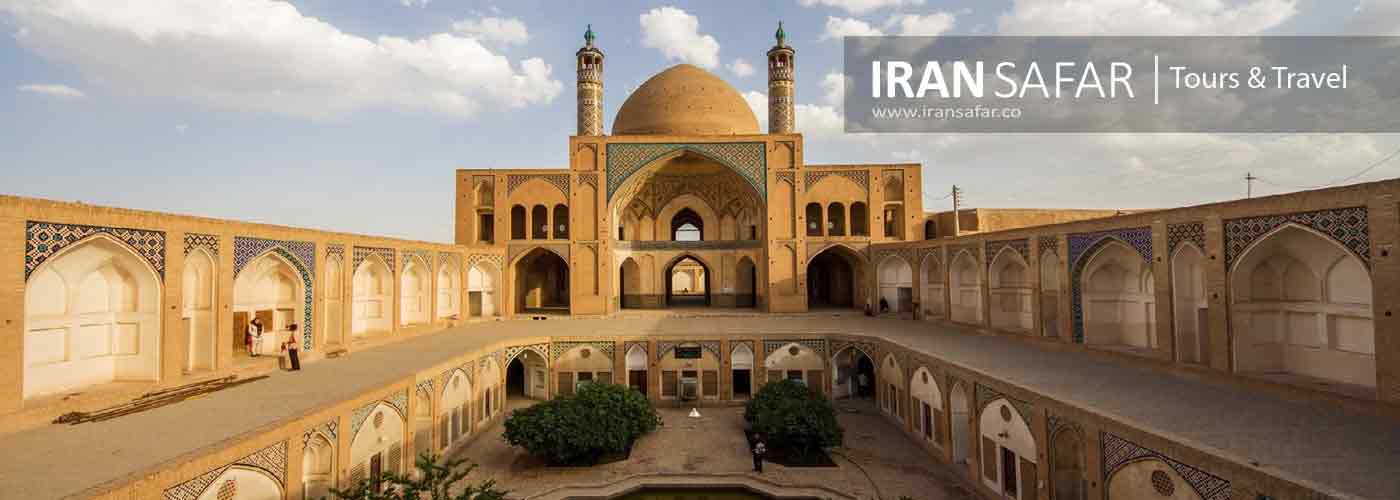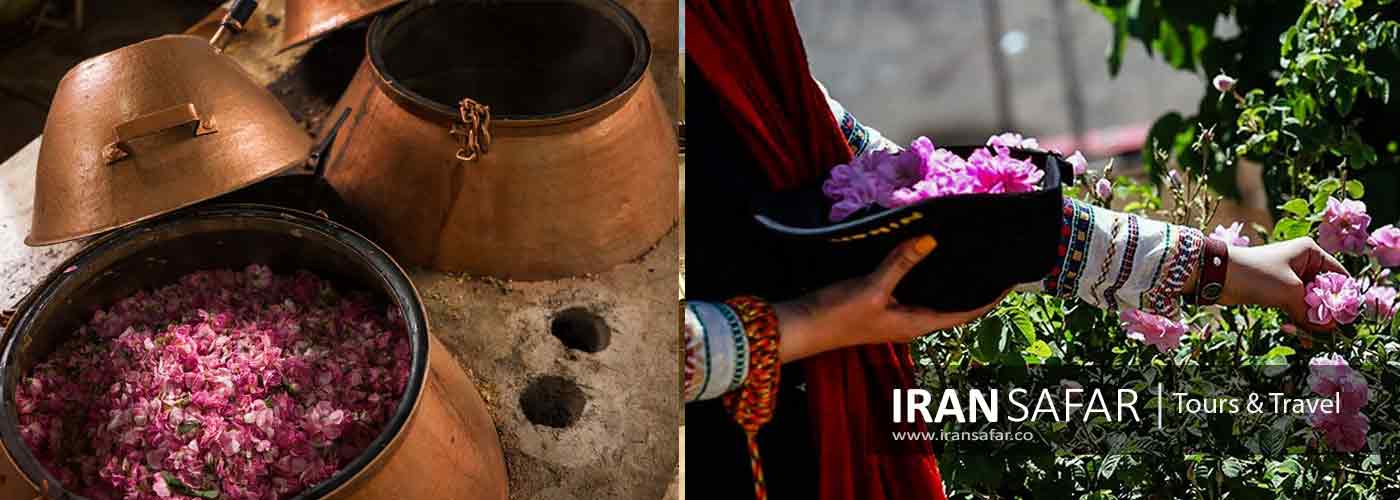Kashan is an ancient oasis town, 250 km from Tehran, famous for its intricately woven carpets and great architecture. Kashan was the favorite city of Shah Abbas the Great, the 16th-century safavid king responsible for so much of Iran’s finest architecture. Located on an altitude of 1600 m on the rim of the central Salt Desert, the city dates back to prehistoric times. The city name means “summer houses built of wood and reeds” and it is known for its carpets, velvet, glazed tiles, pottery and distillation of Roses for making rosewater.
 Roof of Broujerdi house, Kashan
Roof of Broujerdi house, Kashan
History of Kashan
Archeological discoveries in the Sialk Hills which lie 2.5 miles (4 km) west of Kashan reveal that this region was one of the primary centers of civilization in pre-historic ages. Hence Kashan dates back to the Elamite period of Iran. The Sialk ziggurat still stands today in the suburbs of Kashan after 7000 years.
A number of early references to a pre-Islamic Kashan may well be anachronistic and can be attributed to the collection of nearby villages and townships. One notable reference relates to a seemingly exaggerated 20,000 men force from Qom and Kashan, led by a certain Āḏargerd, taking part in the deciding battle of Nehāvand in the year 642. Following his defeat, Yazdgerd III is said to have retreated to Kashan on his way to Fars. Soon after, around 645 and following considerable local resistance, Kashan reportedly fell to the invading Arab army under the leadership of Abu Musa Ashari.
Kashan’s growth in the Islamic Middle Ages was in part due to its relative distance from severe seismic activity and the abundance of sanitary drinking water provided by an advanced underground water canal system, called Qanat. The city’s dry and hot climate, less hospitable to pathogens, may account for higher resistance to trans-regional epidemics. A strong economy benefited from a robust transit trade and a diverse ecosystem that could accommodate a range of activities, including camel breeding at the edge of the desert in the villages of Ārān and Bidgol, winemaking by the sizable local Jewish community using grapes from the nearby slopes, a thriving textile and silk industry supported by local mulberry trees, and a thriving ceramic industry that benefited from a rare combination of local minerals.
What to see in Kashan
Although Kashan is full of beautiful sites, but it is a small enough to walk to most of the main sites, where you can get pleasantly lost walking through beautiful laneways and if you’re lucky, onto Kashan’s famous rooftops. here you can find the list of what you should visit during your stay in Kashan.
Historical Houses of Kashan
it would be a lost to visit Kashan and not to explore its old houses. Make sure you spend at least half a day to explore Kashan historical mansions such as Tabatabai house, Broujerdi house, Abbassian house and The other ones which are converted to beautiful but costly hotels, where you can stay in and feel how it has been to live in one of these residential buildings.
During the 18th and 19th century the prosperous merchants of Kashan were after building bigger and more luxurious houses to quench their wishes and suit their culture. Therefore, local architects’ knowledge and efficiency helped the accumulated wealth to create masterpieces which are called Kashan historical houses today located in Kashan old town.
 Tabatabai mansion, Kashan
Tabatabai mansion, Kashan
Royal Gardens of Fin
Fin garden is a beautiful 16th century Persian garden with natural springs and great palaces. The Bagh-i-Shah of Fin is a palace that combines the architectural features of the Safavid, Zandiyeh and Qajar periods. this ancient garden contains numerous old oak and beach trees, tall cypresses, pools, abundant water-supply (Cheshmeh Sulaimani), with numerous spouts and an old historical bathing-house.
Perhaps if Amir Kabir‘s assassination in 1852 did not happen at Kashan’s Fin Garden, people would rarely have known this garden and its famous Bath. History books have quoted that prior to the current bath and garden at this site, it was during the reign of Al-e-buyeh dynasty (13th c) , when initial design of garden was done by Ghiasuddin Jamshid Kashani. Later it was completely destroyed by an earthquake and once again by the Mongol invasion, until it was restored during Safavid era in occasion of King Ismail’s coronation and later designed by Sheikh Bahai to become a popular pleasure spot for Safavid royal family.
 Fin garden, Kashan
Fin garden, Kashan
Agha Bozorg Mosque
Agha bozorg mosque consists of two large iwans, one in front of the mihrab and the other by the entrance, and two courts in the middle which comprises a garden with trees and a fountain. Agha bozorg mosque has been described as “the finest Islamic complex in Kashan and one of the best of the mid-19th century”.
The most eye-catching feature of this place is definitely its blue and turquoise tiles which are tactfully and beautifully placed next to each other to form an interesting Persian geometric architecture.
this beautiful building is still used as a Madrasa in which young students can be seen studying in the second courtyard.

Agha Bozorg Mosque, Kashan
Bath of Sultan Amir Ahmad – Kashan
Sultan Amir Ahmad Bath is one of the most important historical Iranian Baths in Kashan, which was registered as one of the national heritage of Iran in 1976. This bath covers a total area of 1102 square meters and takes its name from the adjacent Imamzadeh.
Based of information obtained from the artifacts obtained during the earthquake of 1150, this bath was built during the Seljuk period, but its cloak room dates to the Qajar period 19th century. Some people think that the bath was rebuilt on the ruins of the previous hammam and a small bath was added to it. in 1996, The municipality of Kashan bought this historic mosque to save it from destruction by repairing and restoring it.
Also Read: Persian Hammams | All about Traditional Iranian Bath
This Hammam was converted into a traditional restaurant for some time after its renovation, until it was finally turned into a museum and today it is under the supervision of the Kashan city hall. The fascinating decorations, plaster carvings and lime stuccos, blue and gold tiles, vaulted ceilings, murals and stained glass of Sultan Amirahmad Hammam, have made this collection a special and spectacular work.

Sialk Historical Mounds
Approximately 4,500 years BC., a civilization settled in current Kashan who used tools made of stones and bones. There is a possibility that the former residents of this region had succumbed to their successors. Here, Elamite slabs of clay have been found, and due to the links of this community with that of the civilization of Shush (Susa), about 5,500 years ago, they learned to write. Thereby, several clay slabs with the most ancient Elamite script are vestiges of this area. Evidences found in the cemetery between the two hillocks are related to the fresh immigrants to the Sialk Mounds, which bears a strong resemblance to the discoveries in the Giyan Hillock of Nahavand and Khordin of Savoj Bollaq.

Sialk Mounds, Kashan
The site of Sialk Mounds is one of the most important archaeological sites in the central plateau of Iran and is originally the ruins of the oldest ancient ziggurat in Iran, where the first urban civilization was formed.
This area includes the northern mound (small sialk), with an area of about five hectares, the southern mound (large sialk), with an area of about eight hectares, and two cemeteries named Cemetery A and Cemetery B.
These hills, from time to time, display the works of different eras of human civilization, including the Neolithic, Copper and Stone Ages, urban periods, Bronze and Iron Ages, and the Median period.
Spring Ceremony of Distillation of Rosewater
Kashan Province is also famous for its Rosewater, which is the main product of Qamsar, Niyasar and Barzook, smaller towns of Kashan province, which where the three main producers of rosewater for over 800 years. In spring, The Ceremony of Rosewater Distillation (Marasem-e-Golabgiri), flower picking (Golchini) and extraction of rosewater (Golabgiri), starts when rose buds begin to open, usually mid May to early June. In this season, the whole town is filled with the aroma of roses and rosewater. All families and outsiders helps for picking roses from early morning till evening. Every year the festival of rose and rosewater is held in the region. In the evenings music is played and people sing till midnight, to entertain the visitors and tourists, and to sooth the weary gardeners and their families. The festival is truly worth visiting.

Abyaneh Village
Abyaneh is a village on the north-western slope of Mt. Karkas, 28 Km from the town of Natanz and 60 Km from Kashan. This welcoming village is known by UNESCO as a historical village. The local traditional costumes as well as the architecture of the village still afford a picture of life in ancient rural Iran. The word Abyaneh stems from “Viyona”, which means Place of Willow Trees. Most residents of this village were Zoroastrians, but during the reign of Shah Ismail, a Safavid king, they converted to Islam.
compact with narrow and sloped lanes, and houses located on the slope as if placed on a stairway, the village is really picturesque. The houses bear an ancient architectural style, featured by the use of clay as the construction material and latticed windows and wooden doors. Similar to Masouleh, The roofs of some houses are used to serve as the courtyard for other houses higher up on the slope. With a unique reddish hue, the Village is one of the oldest in Iran, attracting numerous native and foreign tourists year-round, especially during traditional feasts and ceremonies such as Ashura or new year holidays.
Also Read : 10 most fascinating villages of Iran




Comment (0)